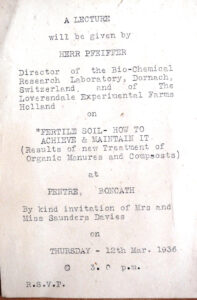Ehrenfried Pfeiffer to Wales
Pfeiffer comes to Wales
 At the invitation of Barbara Saunders Davies Ehrenfried Pfeiffer gives a lecture at the college entitled ‘Fertile Soil‘.
At the invitation of Barbara Saunders Davies Ehrenfried Pfeiffer gives a lecture at the college entitled ‘Fertile Soil‘.
Barbara Saunders-Davies wrote of Dr Pfeiffer:
It was in 1935 that Mr Heywood-Smith brought some fine ears of wheat back from a visit to Dornach. He told us that these had been developed by Dr Pfeiffer from a small, primitive, almost wild wheat by breeding and biodynamic methods. This was my first introduction to any practical applications of Dr Steiner’s ideas and it impressed me.
As Dr Pfeiffer was coming over shortly to lecture on Bio-dynamic agricultural methods it was possible to arrange a meeting, down in Pembrokeshire at my home (Pentre Mansion). In this way he came to stay with us in Wales and lecture to about 70 farmers including agricultural experts from the University and Plant breeding station in Aberystwyth.
Besides much travelling in Europe and the USA he now came over to England every year to lecture, foster and advise the BD work in this country. Lady MacKinnon, Mr Hoskins, Nr Binnie, Miss Sergeant and Miss Cross were active workers in the Home Counties. He also had contacts with the Soil Association, Lord Lymington, Lord Northbourne and many others who were concerned about the health of the soil. To see him demonstrating the correct fermentation in compost heaps and fondling handfuls of earthworms one would never have guessed he had to overcome a particular repugnance for worms.The organic unity of a farm or a landscape was of great importance to him. Trees and their forms were significant in judging the etheric landscape and he was actively associated with forest nursery work in Germany. He was in close contact with with what was being done in other countries. Great was his delight one year when his most promising wheat had suddenly burst out with a number of spontaneous mutations, simultaneously in Holland, Germany and Switzerland. Among the variations was one with the looseness of husk necessary to thresh well which was a quality he particularly needed. He christened the strain ‘Theodora’ (Experimental work is still continuing to fix some of these strains.)
After learning from him about Externsteine and Carnac, I took him to see some of the neolithic monuments which abound in my home county of Pembrokeshire – known to the ancients as the ‘Land beyond the Veil’ where priests and princes sought to be buried looking westward towards the lost ‘Isles of the Blessed.’
He seemed to feel at home among the grey crystalline boulders of Pentre Ifan with its great cromlech who’s mighty capstone is so finely tapered and delicately poised that it appears to float in space. He noted the large rather symmetrical stone behind which the sun could be obscured at Winter Solstice and the semi circle of stones facing south. This he concluded was probably a site where they celebrated the dying Sun God on the day before the Solstice.
At St Davids Head the cromlech faces South-East and was probably used to celebrate the day after mid-winter – the resurrection of the new-born Sun spirit. At this great mystery centre the past seemed to live before him, and as we explored further, we discovered a cave which suggested further evidence of of the death and resurrection theme. It appears more than natural and is somewhat tom-like, with a low entrance, but with height enough inside for a man to stand up in. How well it would serve for the Temple Sleep after which the neophyte could mount up the slope through six stone circles to the brow of the head. There all the streams of the Atlantic seem to flow together and rise up to Heaven and that day it was encircled by a crown of white cloud.
On another occasion, returning from ann expedition near Strumble Head, above Fishguard, he suddenly said for no apparent reason, ‘Stop there is something over there.’ There was nothing to distinguish this particular piece of rough , rock strewn moorland from the surrounding country but we stopped and climbed over a stone wall. At first there seemed nothing of interst but careful observation revealed several alignments of small stones about two feet high intersecting each other and forming a star. These alignments pointed to sunrise and sunset at summer and winter solstices and the equinoxes. In fact here was a sort of astronomical clock of some 20 paces in diameter. It was the evening of the 22nd March and we watched the orange sun set behind the stones.
There are some very fine celtic crosses in West Wales. Pfeiffer was particularly impressed by the one at Llanbadarn Church, near Aberystwyth. On the shaft is portrayed a human torso with a large spiral in the region of of the heart from which one stream descends while the other rises toward the head which is surrounded by the aureol of rays. Some of the simpler crosses he noted, combine in a remarkable way the essential form of the human body with that of the cross.
Pfeiffer admitted that this contact with the Celtic stream from early Druidic times to the legends of the Holy Grail had moved him profoundly and had greatly deepened his feeling and aided his approach to the Mystery of Christ. So much did he value it that he brought his wife and family down one year. He wanted his children to be given this geographical connection with all that he felt it represented spiritually.